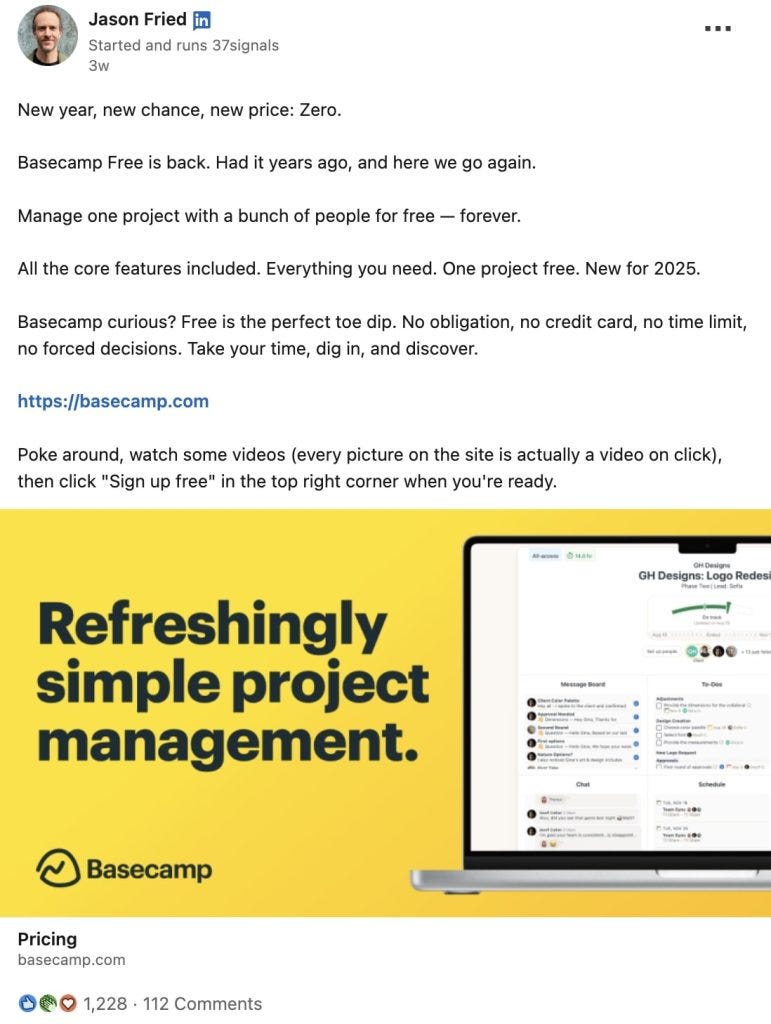Product-led play?
👋 Hey, I’m George Chasiotis. Welcome to GrowthWaves, your weekly dose of B2B growth insights—featuring powerful case studies, emerging trends, and unconventional strategies you won’t find anywhere else.
A few weeks ago, we had one of the live events we started doing this year at Minuttia.
One of the points on the agenda was the pricing change that Basecamp did.
I have huge respect for Basecamp and its founders and was excited to see the attention the announcement got.
For most people, this was a simple pricing update.
For me, it was something else.
What changed?
On January 6th, Jason Fried, Founder and CEO at 37signals (Basecamp’s parent company), made this post on LinkedIn:
The post attracted 1,228 engagements and 112 comments (in total).
Then he posted a slight variation of the post on X (formerly Twitter):
109K views for a post announcing a new plan for Basecamp isn’t bad, right?
Here, too, there were comments, reposts, bookmarks, and likes.
Even though we don’t have a view of how many impressions the post attracted on LinkedIn, we can see that the 2 posts combined did really well.
They got attention and engagement, which is what every person posting content on social media wants.
But, what changed, really?
What changed is that Basecamp introduced a new free plan, as you can see below:
The free forever plan is designed for those who want to use Basecamp less frequently.
The main difference (and value determinant) is the number of projects the user can run and the storage space they have available.
So, this looks like a simple introduction to a free plan by one of the most popular project management tools.
What’s with all the buzz, right?
That move wasn’t just about bringing a free plan to Basecamp.
What most people are missing
Basecamp’s move is a brilliant product-led growth (PLG) play.
By giving users the chance to use the product for free forever, you show confidence that the product will help them grow with it so that they can then choose one of the other 2 (paid) plans.
One of PLG’s main premises is that the product is enough to turn users into paying customers.
In Basecamp’s case, the number of active projects and storage space are value metrics, illustrating the value someone gets from the product.
In simple terms, if they need to launch more projects with Basecamp and need more storage space, they must be getting more value out of it, right?
So, a free forever plan is cool, but the underlying message is:
We feel very confident that you will enjoy and grow with our product.
And, from what we’ve seen from so many PLG companies having a free forever plan, it works.
It works for Basecamp, too.
Following the announcement, they added a counter that counts sign-ups to their pricing page:
And judging by the CTA texts that read ‘Sign up free,’ the counter counts just free (forever plan) sign-ups.
This adds extra social proof, even though most people coming to Basecamp already know what Basecamp is.
Of course, many users will come to Basecamp and ignore the ‘Basecamp Free’ plan because it does not meet their needs.
For example, they may want to migrate from another tool (e.g., Asana) to Basecamp.
Which is fine since there’s a plan for that.
For all other users who want to start small and don’t need one of the other 2 plans, there’s now a pricing plan for them.
Final thoughts
I believe that PLG is a powerful growth motion.
It doesn’t apply to all companies, and several companies rely on other growth motions (e.g., sales).
However, I think PLG will have a tough time moving forward for various reasons (which I won’t get into here).
But Basecamp has all the attention they need.
That attention then translates into high volumes of free sign-ups and a product to support the motion.
This PLG play then makes perfect sense.
Well done, Basecamp!





